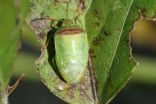(Press-News.org) SAN DIEGO, Calif. -- (Aug. 24, 2015) -- A new survey on sexual victimization issues at the University of Oregon reaffirms previous findings that there is a need to increase awareness about available services, while decreasing negative perceptions of institutional support.
Psychology professor Jennifer Freyd provided preliminary findings of the UO survey at the 20th International Summit & Training on Violence, Abuse & Trauma during a keynote session on "Campus Sexual Assault: Current Research and Prevention Approaches."
New issues also surfaced among the key findings of the 2015 survey -- one of four pilot studies being done in a national effort by the Administrator Researcher Campus Climate Collaboration, or ARC3, that involves 20 U.S. university campuses. The UO survey also incorporated data on several issues not covered under ARC3.
While women seeking graduate degrees were at lower risk of non-consensual sexual contact than women seeking undergraduate degrees (8 percent vs. 20 percent), female graduate students were at significantly higher risk of experiencing harassment-related events from faculty or staff than were undergraduate women (38 percent vs. 28 percent).
Women seeking law degrees also reported more harassment-related events from fellow students and from faculty and staff than graduate students pursuing master's degrees and doctorates in other fields.
At the UO, 1,334 students -- including 501 undergraduate and 324 graduate-level women -- completed the online 2015 survey that closely mirrored a survey of 982 undergraduates in 2014. The new survey included 539 graduate students.
Fifty-two percent of 795 undergraduates who completed the 2015 survey were "not at all" aware that the UO had Title IX officers to handle complaints about sexual issues; 50 percent did not know a bias-response team existed. There also was lack of awareness about student legal services (39 percent) and sexual assault support services (33 percent).
"These numbers suggest a need for more education so students know about services that are available to them," Freyd said. "Efforts have been made, but these efforts need to be more engaging and pertinent to students so they don't tune out."
"I am grateful that Jennifer Freyd has done research to provide us with important insight into this pressing matter," said UO President Michael H. Schill. "While the results do not surprise me and are not inconsistent with data from other universities that does not mean that they are acceptable. To the contrary, any amount of sexual violence on campus is too much. I look forward to analyzing the data and working with our faculty, administrators and students to combat the problem."
Findings involving women students in the law school came as a surprise and need further examination to see if the responses are similar at other law schools or just reflective of the UO school, Freyd said. Twenty-nine of the 35 women law students surveyed (83 percent) experienced harassment-related events from other students and 20, or 57 percent, from faculty and staff.
"I am aware our sample from the law school is small and that these results are preliminary, but the results are statistically significant," Freyd said. "I don't know if anyone has done this comparison at the graduate level. We didn't expect this. Initially, the graduate findings for sexual violence raised few concerns."
The 2015 UO survey repeated many of the same questions as on the previous version, but it also incorporated positive factors students experienced and more questions about institutional response and betrayal.
Other key 2015 findings from Freyd's team, which included graduate students Marina Rosenthal, Carly Smith, Alec Smidt and Jennifer Gomez, were:
One in five undergraduate women reported being victims of attempted or completed unwanted contact or penetration. Compared to 2014, there was a decline, from 35 percent to 28 percent, in the reporting of attempted and completed physical sexual contact.
Perceptions of 11 scenarios about institutional reactions to sexual violence were low. Just 36 percent of undergraduates felt it was likely that the institution would provide such supports as academic, housing or safety accommodations for victims. Sixty percent were confident that the UO would take a report seriously and that it would maintain privacy for the victim.
Sixty-seven percent of undergraduate women felt safe from dating violence, 48 percent from sexual violence, 52 percent from stalking and 42 percent from sexual harassment. Similar trends were found among female graduate students.
"To me, these numbers are tragic," Freyd said. "There is a huge cost in feeling unsafe. Women are bearing this cost all the time. It's using up mental space and emotional resources. It reduces the resources that they have available for other activities. We know that people who have these experiences of victimization and especially those who felt institutional betrayal tend to disengage."
The ARC3 initiative emerged from the Madison Summit on Campus Climate and Sexual Misconduct held in Wisconsin in February, in which Freyd participated. The summit was a follow-up to a gathering of campus representatives from student and legal affairs, advocates, students, law enforcement, and sexual assault and harassment researchers who met in October 2014 in Georgia.
INFORMATION:
Source: Jennifer Freyd, professor of psychology, jjf@uoregon.edu
Note: The UO is equipped with an on-campus television studio with a point-of-origin Vyvx connection, which provides broadcast-quality video to networks worldwide via fiber optic network. There also is video access to satellite uplink and audio access to an ISDN codec for broadcast-quality radio interviews.
CAMBRIDGE, Mass. (August 24, 2015) - By teasing apart the structure of an enzyme vital to the infectious behavior of the parasites that cause toxoplasmosis and malaria, Whitehead Institute scientists have identified a potentially 'drugable' target that could prevent parasites from entering and exiting host cells.
Although toxoplasmosis causes disease only in certain individuals-including immunocompromised patients, pregnant women, and their infants, the T. gondii parasite is closely related to Plasmodium, which causes malaria. Research on T. gondii can provide insights ...
Commonly used antidepressant drugs change levels of a key signaling protein in the brain region that processes both pain and mood, according to a study conducted at the Icahn School of Medicine at Mount Sinai and published August 24 in the Proceedings of the National Academy of Sciences (PNAS). The newly understood mechanism could yield insights into more precise future treatments for nerve pain and depression.
The study was conducted in mice suffering from chronic neuropathic pain, a condition which is caused in mice and humans by nerve damage. Chronic neuropathic ...
Bacteria are best known as free-living single cells, but in reality their lives are much more complex. To survive in harsh environments, many species of bacteria will band together and form a biofilm--a collection of cells held together by a tough web of fibers that offers protection from all manner of threats, including antibiotics. A familiar biofilm is the dental plaque that forms on teeth between brushings, but biofilms can form almost anywhere given the right conditions.
Biofilms are a huge problem in the health care industry. When disease-causing bacteria establish ...
Atlanta, GA - August 24, 2015 - Respiratory syncytial virus (RSV), which is the leading cause of childhood respiratory hospitalizations among premature babies, can be detected from the clothes worn by caregivers/visitors who are visiting infants in the neonatal intensive care unit (NICU), according to research being presented at the International Conference on Emerging and Infectious Diseases in Atlanta, Georgia.
"The aim of this study was to identify potential sources of transmission of RSV in the NICU to better inform infection control strategies," said Dr. Nusrat ...
Atlanta, GA - August 24, 2015 - Experts show that while Middle East Respiratory Syndrome (MERS-CoV), a viral respiratory illness, is infecting less people, it has a higher mortality rate and affects a specific target population when compared to Severe Acute Respiratory Syndrome (SARS-CoV). This research is being presented at the International Conference on Emerging and Infectious Diseases in Atlanta, Georgia.
"The research conducted in this study focuses on understanding what population of individuals are most likely to become infected by MERS-CoV, compared to the population ...
BEAUMONT -- Entomologists in Texas got a whiff of a new stink bug doing economic damage to soybeans in Texas and are developing ways to help farmers combat it, according to a report in the journal Environmental Entomology.
Various types of stink bugs have long been a problem on soybean crops, but when sweeps of fields in southeast Texas netted 65 percent redbanded stink bugs, entomologists realized this particular bug had become the predominant pest problem, according to Dr. Mo Way, an entomologist at the Texas A&M AgriLife Research and Extension Center in Beaumont.
The ...
Philadelphia, PA, August 24, 2015 - Antibiotic-resistant bacteria are a concern for the health and well-being of both humans and farm animals. One of the most common and costly diseases faced by the dairy industry is bovine mastitis, a potentially fatal bacterial inflammation of the mammary gland (IMI). Widespread use of antibiotics to treat the disease is often blamed for generating antibiotic-resistant bacteria. However, researchers investigating staphylococcal populations responsible for causing mastitis in dairy cows in South Africa found that humans carried more antibiotic-resistant ...
Cancer researchers are constantly in search of more-effective and less-toxic approaches to stopping the disease, and have recently launched clinical trials testing a new class of drugs called BET inhibitors. These therapies act on a group of proteins that help regulate the expression of many genes, some of which play a role in cancer.
New findings from The Rockefeller University suggest that the original version of BET inhibitors causes molecular changes in mouse neurons, and can lead to memory loss in mice that receive it. Published in Nature Neuroscience on August ...
Resveratrol, a compound found commonly in grape skins and red wine, has been shown to have several potentially beneficial effects on health, including cardiovascular health, stroke prevention and cancer treatments. However, scientists do not yet fully understand how the chemical works and whether or not it can be used for treatment of diseases in humans and animals.
Now, researchers at the University of Missouri have found that resveratrol does affect the immune systems of dogs in different ways when introduced to dogs' blood. Sandra Axiak-Bechtel, an assistant professor ...
In a new effort, researchers from the University of Pennsylvania and Baylor College of Medicine have used advanced imaging technology to fill in details about the underlying cause of canine diabetes, which until now has been little understood. For the first time, they've precisely quantified the dramatic loss of insulin-producing beta cells in dogs with the disease and compared it to the loss observed in people with type I diabetes.
"The architecture of the canine pancreas has never been studied in the detail that we have done in this paper," said Rebecka Hess, professor ...



